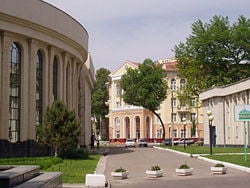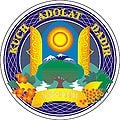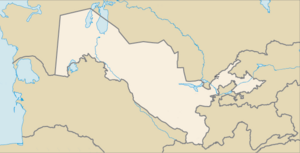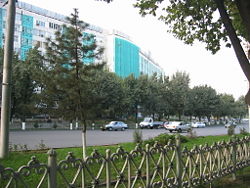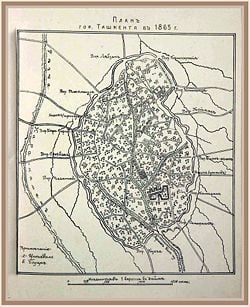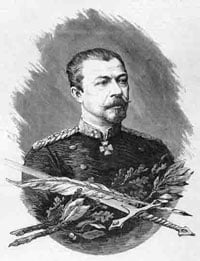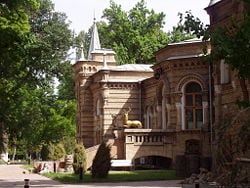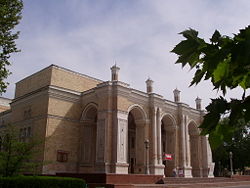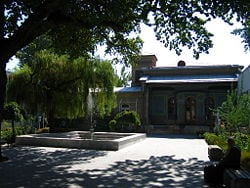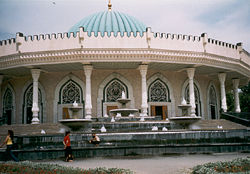Difference between revisions of "Tashkent" - New World Encyclopedia
Mary Anglin (talk | contribs) m |
Rosie Tanabe (talk | contribs) |
||
| (14 intermediate revisions by 4 users not shown) | |||
| Line 1: | Line 1: | ||
| − | {{Images OK}}{{Submitted}} | + | {{Images OK}}{{Submitted}}{{Approved}}{{copyedited}} |
{{Infobox Settlement | {{Infobox Settlement | ||
| − | <!--See the Table at Infobox | + | <!--See the Table at Infobox settlement for all fields and descriptions of usage—> |
<!-- Basic info ----------------> | <!-- Basic info ----------------> | ||
|official_name = Tashkent | |official_name = Tashkent | ||
| − | |other_name = | + | |other_name = Toshqand, Toshkand |
| − | |native_name = <small>{{lang-uz|'''Toshkent''', Тошкент}}<br/> {{lang-ru|Ташкент}} </small> <!-- for cities whose native name is not in English —> | + | |native_name = <small>{{lang-uz|'''Toshkent''', Тошкент}}<br /> {{lang-ru|link=no|Ташкент}} </small> <!-- for cities whose native name is not in English —> |
| − | |nickname = | + | |nickname = |
|settlement_type = <!--For Town or Village (Leave blank for the default City)—> | |settlement_type = <!--For Town or Village (Leave blank for the default City)—> | ||
|motto = | |motto = | ||
<!-- images and maps -----------> | <!-- images and maps -----------> | ||
|image_skyline = Tachkent moderne.jpg | |image_skyline = Tachkent moderne.jpg | ||
| − | |imagesize = | + | |imagesize = |
| − | |image_caption = Modern Tashkent | + | |image_caption = Modern Tashkent |
| − | |image_flag = | + | |image_flag = |
|flag_size = | |flag_size = | ||
| − | |image_seal = | + | |image_seal =Tashkent emblem.jpg |
| − | |seal_size = | + | |seal_size =120px |
| − | |image_shield = | + | |image_shield = |
|shield_size = | |shield_size = | ||
|city_logo = | |city_logo = | ||
|citylogo_size = | |citylogo_size = | ||
| − | |image_map = | + | |image_map = |
| − | |mapsize = | + | |mapsize = |
| − | |map_caption = | + | |map_caption = |
| − | |image_map1 = | + | |image_map1 = |
| − | |mapsize1 = | + | |mapsize1 = |
| − | |map_caption1 = | + | |map_caption1 = |
|image_dot_map = | |image_dot_map = | ||
|dot_mapsize = | |dot_mapsize = | ||
| Line 34: | Line 34: | ||
|pushpin_label_position = <!-- the position of the pushpin label: left, right, top, bottom, none —> | |pushpin_label_position = <!-- the position of the pushpin label: left, right, top, bottom, none —> | ||
|pushpin_map_caption = Location in Uzbekistan | |pushpin_map_caption = Location in Uzbekistan | ||
| − | |pushpin_mapsize = | + | |pushpin_mapsize =300 |
<!-- Location ------------------> | <!-- Location ------------------> | ||
| + | |coordinates_region = UZ | ||
|subdivision_type = Country | |subdivision_type = Country | ||
| − | |subdivision_name = [[ | + | |subdivision_name = [[File:Flag of Uzbekistan.svg|25px]] Uzbekistan |
|subdivision_type1 = Province | |subdivision_type1 = Province | ||
|subdivision_name1 = [[Tashkent Province]] | |subdivision_name1 = [[Tashkent Province]] | ||
| − | |subdivision_type2 = | + | |subdivision_type2 = |
| − | |subdivision_name2 = | + | |subdivision_name2 = |
| − | |subdivision_type3 = | + | |subdivision_type3 = |
| − | |subdivision_name3 = | + | |subdivision_name3 = |
| − | |subdivision_type4 = | + | |subdivision_type4 = |
|subdivision_name4 = | |subdivision_name4 = | ||
<!-- Politics -----------------> | <!-- Politics -----------------> | ||
|government_footnotes = | |government_footnotes = | ||
|government_type = | |government_type = | ||
| − | |leader_title = | + | |leader_title = Mayor |
| − | |leader_name = | + | |leader_name = Rakhmonbek Usmonov |
|leader_title1 = <!-- for places with, say, both a mayor and a city manager —> | |leader_title1 = <!-- for places with, say, both a mayor and a city manager —> | ||
|leader_name1 = | |leader_name1 = | ||
| Line 60: | Line 61: | ||
|leader_name4 = | |leader_name4 = | ||
|established_title = Settled | |established_title = Settled | ||
| − | |established_date = 5th to 3rd centuries | + | |established_date = 5th to 3rd centuries BC |
|established_title2 = <!-- Incorporated (town) —> | |established_title2 = <!-- Incorporated (town) —> | ||
| − | |established_date2 = | + | |established_date2 = |
|established_title3 = <!-- Incorporated (city) —> | |established_title3 = <!-- Incorporated (city) —> | ||
|established_date3 = | |established_date3 = | ||
<!-- Area ---------------------> | <!-- Area ---------------------> | ||
| − | |area_magnitude = | + | |area_magnitude = |
|unit_pref = <!--Enter: Imperial, if Imperial (metric) is desired—> | |unit_pref = <!--Enter: Imperial, if Imperial (metric) is desired—> | ||
|area_footnotes = | |area_footnotes = | ||
| − | |area_total_km2 = <!-- ALL fields dealing with a measurements are subject to automatic unit conversion—> | + | |area_total_km2 = 334.8 <!-- ALL fields dealing with a measurements are subject to automatic unit conversion—> |
| − | |area_land_km2 = <!--See table @ Template:Infobox | + | |area_land_km2 = <!--See table @ Template:Infobox settlement for details on automatic unit conversion—> |
|area_water_km2 = | |area_water_km2 = | ||
|area_total_sq_mi = | |area_total_sq_mi = | ||
| Line 84: | Line 85: | ||
|area_blank1_sq_mi = | |area_blank1_sq_mi = | ||
<!-- Population -----------------------> | <!-- Population -----------------------> | ||
| − | |population_as_of = | + | |population_as_of = 2008 |
|population_footnotes = | |population_footnotes = | ||
|population_note = | |population_note = | ||
| − | |population_total = | + | |population_total = 2200000 |
| − | |population_density_km2 = | + | |population_density_km2 = auto |
|population_density_sq_mi = | |population_density_sq_mi = | ||
|population_metro = | |population_metro = | ||
| Line 98: | Line 99: | ||
|population_blank1_title = | |population_blank1_title = | ||
|population_blank1 = | |population_blank1 = | ||
| − | |population_density_blank1_km2 = | + | |population_density_blank1_km2 = |
|population_density_blank1_sq_mi = | |population_density_blank1_sq_mi = | ||
<!-- General information ---------------> | <!-- General information ---------------> | ||
|timezone = | |timezone = | ||
|utc_offset = +5 | |utc_offset = +5 | ||
| − | |timezone_DST = | + | |timezone_DST = |
| − | |utc_offset_DST = | + | |utc_offset_DST = |
|latd=41 |latm=16 |lats= |latNS=N | |latd=41 |latm=16 |lats= |latNS=N | ||
|longd=69 |longm=13 |longs= |longEW=E | |longd=69 |longm=13 |longs= |longEW=E | ||
| − | |elevation_footnotes = <!--for references: use <ref> </ref> tags—> | + | |elevation_footnotes = <!--for references: use<ref> </ref> tags—> |
| − | |elevation_m = | + | |elevation_m = |
|elevation_ft = | |elevation_ft = | ||
<!-- Area/postal codes & others --------> | <!-- Area/postal codes & others --------> | ||
| Line 118: | Line 119: | ||
|blank1_name = | |blank1_name = | ||
|blank1_info = | |blank1_info = | ||
| − | |website = http:// | + | |website = http://tashkent.uz/ |
| − | |footnotes = | + | |footnotes = |
}} | }} | ||
| − | |||
| − | |||
| + | '''Tashkent''' ({{lang-uz|'''Toshkent,''' Тошкент}}; {{lang-ru|Ташкент}}, {{lang-tr|Taşkent}}) is the [[capital]] of [[Uzbekistan]] and the [[Tashkent Province]]. The city was an important center for trade along the [[Silk Road]] and continues as a prominent export center to [[Eastern Europe]] for [[silk]], [[cotton]], [[textile]]s, and other products. Tashkent is the main economic and cultural center of [[Central Asia]]. It is located in the most industrially developed section of Uzbekistan. | ||
| + | |||
| + | Few buildings from the city's ancient past remain, most destroyed as a result of the late nineteenth century Russian takeover, the [[Bolshevik Revolution]], and a devastating [[earthquake]] in 1966. However, in 2007, Tashkent was named the cultural capital of the [[Islam]]ic world by the Islamic Educational, Scientific and Cultural Organization in recognition of its efforts to "nourish Islamic culture and science, and pay careful attention to historical monuments … which have preserved theological works from the Islamic Renaissance era."<ref name=VV>Vasilina Vasilyeva, [http://mnweekly.ru/world/20070524/55252222.html Tashkent Touts Islamic University,] ''Moscow News Weekly''. Retrieved October 21, 2008.</ref> | ||
| + | {{toc}} | ||
As the capital of Uzbekistan, in the early twenty-first century the city had issues with the curtailment of [[human rights]] under the nation's authoritarian presidential rule, [[terrorism]] from Islamic militants, and economic stagnation. The city is a primary source of cultural pride for the nation. Its future prosperity depends on the willingness of the nation's leaders to establish basic civic freedoms and lead the country into [[economics|economic]] and [[politics|political]] stability. | As the capital of Uzbekistan, in the early twenty-first century the city had issues with the curtailment of [[human rights]] under the nation's authoritarian presidential rule, [[terrorism]] from Islamic militants, and economic stagnation. The city is a primary source of cultural pride for the nation. Its future prosperity depends on the willingness of the nation's leaders to establish basic civic freedoms and lead the country into [[economics|economic]] and [[politics|political]] stability. | ||
| Line 130: | Line 133: | ||
[[Image:Tashkent street near Darhan.jpg|thumb|left|250px|The view of the street near Darkhan.]] | [[Image:Tashkent street near Darhan.jpg|thumb|left|250px|The view of the street near Darkhan.]] | ||
| − | ''Tash'' | + | ''Tash,'' in the Turkic language, means "stone," while ''kand,'' ''qand,'' ''kent,'' ''kad,'' ''kath,'' and ''kud'' are derived from the [[Sogdian]] word ''kanda'', which means "town" or "city." In medieval times, the town and the province were known as "Chach." Later, the town came to be known as Chachkand/Chashkand, meaning "Chach City." After the sixteenth century, the name was changed to Tashkand, which, as "stone city," was more meaningful. The modern spelling of Tashkent reflects [[Russian language|Russian]] [[orthography]]. |
Tashkent is located on a well-watered plain to the west of the [[Altai Mountains]] on the [[road]] between [[Shymkent]] and [[Samarkand]], at an elevation 1475 to 1575 feet (450 to 480 meters). It sits at the confluence of the Chirchik river and several of its tributaries and is built on deep alluvial deposits (up to 15 meters). | Tashkent is located on a well-watered plain to the west of the [[Altai Mountains]] on the [[road]] between [[Shymkent]] and [[Samarkand]], at an elevation 1475 to 1575 feet (450 to 480 meters). It sits at the confluence of the Chirchik river and several of its tributaries and is built on deep alluvial deposits (up to 15 meters). | ||
| − | Tashkent has a a typically continental [[climate]] with mild wet winters and hot dry summers. The average maximum daytime [[temperature]] in January is 37.4°F (3°C), rising to an average maximum of around 92°F (33°C) in July. Mean annual precipitation is 14.7 inches ( | + | Tashkent has a a typically continental [[climate]] with mild wet winters and hot dry summers. The average maximum daytime [[temperature]] in January is 37.4°F (3°C), rising to an average maximum of around 92°F (33°C) in July. Mean annual precipitation is 14.7 inches (375 mm). |
It is a lively tectonic area suffering large numbers of tremors and some [[earthquake]]s. | It is a lively tectonic area suffering large numbers of tremors and some [[earthquake]]s. | ||
| Line 144: | Line 147: | ||
== History == | == History == | ||
[[Image:Plan of Tashkent 1865.JPG|right|thumb|250px|An early map of Tashkent from 1865, showing the walls and gates.]] | [[Image:Plan of Tashkent 1865.JPG|right|thumb|250px|An early map of Tashkent from 1865, showing the walls and gates.]] | ||
| − | |||
[[Image:Chernjaev.jpg|thumb|right|250px|General Mikhail Chernyayev.]] | [[Image:Chernjaev.jpg|thumb|right|250px|General Mikhail Chernyayev.]] | ||
Tashkent began as an [[oasis]] on the [[Chirchik River]], near the [[foothill]]s of the [[Golestan]] Mountains. The principality of ''Chach'' had a main town with a [[Square (geometry)|square]] citadel built around the fifth to third centuries B.C.E., some five miles (eight kilometers) south of the [[Syr Darya]] River. | Tashkent began as an [[oasis]] on the [[Chirchik River]], near the [[foothill]]s of the [[Golestan]] Mountains. The principality of ''Chach'' had a main town with a [[Square (geometry)|square]] citadel built around the fifth to third centuries B.C.E., some five miles (eight kilometers) south of the [[Syr Darya]] River. | ||
| Line 150: | Line 152: | ||
By the seventh century C.E., Chach had over 30 towns and a network of over 50 [[canal]]s, forming a trade center between the [[Sogdiana|Sogdians]] and [[Turkic peoples|Turkic]] nomads. The region came under the sway of [[Islam]] in the early parts of the eighth century. | By the seventh century C.E., Chach had over 30 towns and a network of over 50 [[canal]]s, forming a trade center between the [[Sogdiana|Sogdians]] and [[Turkic peoples|Turkic]] nomads. The region came under the sway of [[Islam]] in the early parts of the eighth century. | ||
| − | Hsien-tsang ([[Xuanzang]]) mentioned the name of the city as ''Zhe-shi''. The Chinese chronicles [[Sujshu]], [[Bejshu]] and [[Tanshu]] mention a possession called Shi or ''Zheshi'' with a capital with the same name since the fifth century C.E. | + | Hsien-tsang ([[Xuanzang]]) mentioned the name of the city as ''Zhe-shi''. The Chinese chronicles [[Sujshu]], [[Bejshu]], and [[Tanshu]] mention a possession called Shi or ''Zheshi'' with a capital with the same name since the fifth century C.E. |
| − | Under the Persian [[Samanid]] [[dynasty]] (819–999), the city came to be known as ''Binkath''. However, the [[Arab]]s retained the old name of ''Chach'' for the surrounding region, pronouncing it ''al-Shash'' instead. The modern Turkic name of ''Tashkent'' (City of Stone) comes from [[Kara-Khanid]] rule in the | + | Under the Persian [[Samanid]] [[dynasty]] (819–999), the city came to be known as ''Binkath''. However, the [[Arab]]s retained the old name of ''Chach'' for the surrounding region, pronouncing it ''al-Shash'' instead. The modern Turkic name of ''Tashkent'' (City of Stone) comes from [[Kara-Khanid]] rule in the tenth century. |
| − | [[Genghis Khan]] destroyed the city in 1219, although the great conqueror had found that the [[Khwarezmid Empire|Khorezmshah]] had already sacked the city in 1214. Under the [[Timurid]]s ( | + | [[Genghis Khan]] destroyed the city in 1219, although the great conqueror had found that the [[Khwarezmid Empire|Khorezmshah]] had already sacked the city in 1214. Under the [[Timurid]]s (fourteenth century) and subsequent [[Shaybanid]] (sixteenth century Uzbek) dynasties, the city revived, despite occasional attacks by the [[Uzbeks]], [[Kazakhs]], [[Persians]], [[Mongols]], [[Oirats]], and [[Kalmyks]]. |
In 1809, Tashkent was annexed to the [[Khanate of Kokand]] (1709–1876). At the time, Tashkent had a population of around 100,000 and was considered the richest city in [[Central Asia]]. It prospered greatly through trade to [[Russia]], but chafed under Kokand’s high taxes. The Tashkent clergy also favored the clergy of [[Bukhara]] over that of Kokand. However, before the [[Emir]] of Bukhara could capitalize on this discontent, the Russian army arrived. | In 1809, Tashkent was annexed to the [[Khanate of Kokand]] (1709–1876). At the time, Tashkent had a population of around 100,000 and was considered the richest city in [[Central Asia]]. It prospered greatly through trade to [[Russia]], but chafed under Kokand’s high taxes. The Tashkent clergy also favored the clergy of [[Bukhara]] over that of Kokand. However, before the [[Emir]] of Bukhara could capitalize on this discontent, the Russian army arrived. | ||
| Line 181: | Line 183: | ||
==Economy== | ==Economy== | ||
| − | [[Uzbekistan]] in 2008 was the world's second-largest [[cotton]] exporter and fifth largest producer, relying heavily on cotton for export earnings, along with [[gold]], [[natural gas]], and [[petroleum|oil]]. Uzbekistan's per capita gross domestic product was estimated at $ | + | [[Uzbekistan]], in 2008, was the world's second-largest [[cotton]] exporter and fifth largest producer, relying heavily on cotton for export earnings, along with [[gold]], [[natural gas]], and [[petroleum|oil]]. Uzbekistan's per capita gross domestic product was estimated at US$2400 in 2007. |
Tashkent is the main economic and cultural center of [[Central Asia]], and is located in the most industrially developed part of Uzbekistan. Much of the city's industry is involved with the manufacture of [[agriculture|agricultural]] and [[textile]] machinery, and production of cotton textiles. It also has various food-processing industries. | Tashkent is the main economic and cultural center of [[Central Asia]], and is located in the most industrially developed part of Uzbekistan. Much of the city's industry is involved with the manufacture of [[agriculture|agricultural]] and [[textile]] machinery, and production of cotton textiles. It also has various food-processing industries. | ||
| − | The city exports to [[Eastern Europe]]; [[silk]], [[cotton]] and textiles, as well as oil, [[coal]], [[copper]], [[sulfur]], [[rice]] and manufactured products such as [[television]] sets, [[automobile]]s and [[tractor]]s. | + | The city exports to [[Eastern Europe]]; [[silk]], [[cotton]] and textiles, as well as oil, [[coal]], [[copper]], [[sulfur]], [[rice]], and manufactured products such as [[television]] sets, [[automobile]]s and [[tractor]]s. |
Media outlets include nine [[Uzbek language]] newspapers, four in [[English language|English]] and nine publications in [[Russian language|Russian]]. There are several television and cable television stations. The [[Tashkent Tower]] is the tallest structure in Central Asia. | Media outlets include nine [[Uzbek language]] newspapers, four in [[English language|English]] and nine publications in [[Russian language|Russian]]. There are several television and cable television stations. The [[Tashkent Tower]] is the tallest structure in Central Asia. | ||
| − | Tashkent province has over 223 miles ( | + | Tashkent province has over 223 miles (360 km) of railways and 2,343 miles (3771 km) of surfaced [[road]]s. Tashkent city had the only metro system in [[Central Asia]] in 2008, since those at [[Astana]] and [[Almaty]] were under construction. Tashkent International Airport, located 12 miles (20 km) from the center of Tashkent, remains the main [[airport]] of [[Uzbekistan]] and the largest airport in Central Asia. |
==Demographics== | ==Demographics== | ||
| Line 202: | Line 204: | ||
[[Image:Tashkent museum of applied arts.jpg|thumb|right|250px|Museum of Applied Arts.]] | [[Image:Tashkent museum of applied arts.jpg|thumb|right|250px|Museum of Applied Arts.]] | ||
[[Image:Historical museum Tashkent.jpg|thumb|250px|The Amir Timur Museum]] | [[Image:Historical museum Tashkent.jpg|thumb|250px|The Amir Timur Museum]] | ||
| − | The Gates of Tashkent, built with the city walls at the close of the | + | The Gates of Tashkent, built with the city walls at the close of the tenth century, have not survived. The last gate was destroyed in 1890, as a result of city growth. The huge open air Chorsu [[bazaar]] is at the center of the old part of the city. Most of the ancient city was destroyed during the [[Russian Revolution of 1917|1917 revolution]]. Much of what remained was destroyed in the 1966 [[earthquake]], meaning that little remains of Tashkent's traditional [[architecture|architectural]] heritage. The city is, however, rich in [[museum]]s and Soviet-era monuments, including the Museum of Cinematic Art and the Museum of History of the Peoples of Uzbekistan. Buildings of interest include: |
* Kukeldash Madrassa, which dates back to the reign of [[Abdullah Khan]] (1557-1598) was being restored in 2008. There was talk of making it into a museum, but it was being used as a [[mosque]]. | * Kukeldash Madrassa, which dates back to the reign of [[Abdullah Khan]] (1557-1598) was being restored in 2008. There was talk of making it into a museum, but it was being used as a [[mosque]]. | ||
| Line 208: | Line 210: | ||
* The Telyashayakh Mosque (Khast Imam Mosque), which contains the [[Uthman Qur'an]], considered to be the oldest extant [[Qur'an]] in the world. Dating from 655 and stained with the [[blood]] of murdered caliph [[Uthman]], it was brought by Timur to [[Samarkand]], seized by the Russians as a war trophy and taken to [[Saint Petersburg]]. It was returned to Uzbekistan in 1989. | * The Telyashayakh Mosque (Khast Imam Mosque), which contains the [[Uthman Qur'an]], considered to be the oldest extant [[Qur'an]] in the world. Dating from 655 and stained with the [[blood]] of murdered caliph [[Uthman]], it was brought by Timur to [[Samarkand]], seized by the Russians as a war trophy and taken to [[Saint Petersburg]]. It was returned to Uzbekistan in 1989. | ||
| − | * The Yunus Khan Mausoleum is a group of three | + | * The Yunus Khan Mausoleum is a group of three fifteenth century [[mausoleum]]s, restored in the nineteenth century, the largest of which is the grave of [[Yunus Khan]], grandfather of [[Mughal Empire]] founder [[Babur]] (1483-1530). |
* The Palace of Prince Romanov, which was the palace of Grand Duke [[Nikolai Konstantinovich]] (1850-1918), a first cousin of [[Alexander III of Russia]], who was banished to Tashkent for some shady deals involving the Russian Crown Jewels. | * The Palace of Prince Romanov, which was the palace of Grand Duke [[Nikolai Konstantinovich]] (1850-1918), a first cousin of [[Alexander III of Russia]], who was banished to Tashkent for some shady deals involving the Russian Crown Jewels. | ||
| Line 214: | Line 216: | ||
* The Alisher Navoi Opera and Ballet Theatre, which was built by the architect who designed [[Lenin's Tomb]] in Moscow, [[Aleksey Shchusev]], and built with [[Empire of Japan|Japanese]] [[prisoner of war]] labor during [[World War II]]. This theater hosts Russian [[ballet]] and [[opera]]. | * The Alisher Navoi Opera and Ballet Theatre, which was built by the architect who designed [[Lenin's Tomb]] in Moscow, [[Aleksey Shchusev]], and built with [[Empire of Japan|Japanese]] [[prisoner of war]] labor during [[World War II]]. This theater hosts Russian [[ballet]] and [[opera]]. | ||
| − | * The Fine Arts Museum of Uzbekistan, which contains a major collection of art from the pre-Russian period, including [[Sogdian]] murals, [[Buddhism|Buddhist]] statues and [[Zoroastrian]] art, along with a more modern collection of | + | * The Fine Arts Museum of Uzbekistan, which contains a major collection of art from the pre-Russian period, including [[Sogdian]] murals, [[Buddhism|Buddhist]] statues and [[Zoroastrian]] art, along with a more modern collection of nineteenth and twentieth century [[applied art]], such as [[suzani]] embroidered hangings. Of more interest is the large collection of paintings "borrowed" from the [[Hermitage Museum|Hermitage]] by Grand Duke Romanov to decorate his palace in exile in Tashkent, and never returned. Behind the museum is a small park, containing the neglected graves of the [[Bolshevik]]s who died in the [[Russian Revolution of 1917]] and to [[Ossipov]]'s treachery in 1919, along with first Uzbekistani President [[Yuldush Akhunbabayev]]. |
| − | * The Museum of Applied Arts, which is housed in a traditional house originally commissioned for a wealthy tsarist diplomat. The house itself is the main attraction, rather than its collection of | + | * The Museum of Applied Arts, which is housed in a traditional house originally commissioned for a wealthy tsarist diplomat. The house itself is the main attraction, rather than its collection of nineteenth and twentieth century [[applied arts]]. |
* The Amir Timur Museum, which is an impressive building with a brilliant blue dome and ornate interior. Inside, the exhibits of [[Timur]] and of President [[Islom Karimov]] vie for the visitor's attention. The [[Gardening|gardens]] outside contain a statue of Timur on horseback, surrounded by some of the nicest gardens and fountains in the city. | * The Amir Timur Museum, which is an impressive building with a brilliant blue dome and ornate interior. Inside, the exhibits of [[Timur]] and of President [[Islom Karimov]] vie for the visitor's attention. The [[Gardening|gardens]] outside contain a statue of Timur on horseback, surrounded by some of the nicest gardens and fountains in the city. | ||
| Line 231: | Line 233: | ||
==References== | ==References== | ||
| − | * Allworth, Edward. 1990. ''The | + | * Allworth, Edward. 1990. ''The Modern Uzbeks: From the Fourteenth Century to the Present: A Cultural History.'' Stanford, CA: Hoover Institution Press, Stanford University. ISBN 0817987312. |
| − | * Bulatov, M., and T. F. Kadyrova. 1977. ''Tashkent''. Leningrad: Aurora Art Publishers. OCLC 5205615 | + | * Bulatov, M., and T. F. Kadyrova. 1977. ''Tashkent''. Leningrad: Aurora Art Publishers. OCLC 5205615. |
| − | * Moorcroft, William, and George Trebeck. 1841. ''Travels in the Himalayan provinces of Hindustan and the Panjab, in Ladakh and Kashmir, in Peshawar, Kabul, Kunduz, and Bokhara: from 1819 to 1825''. London: J. Murray. OCLC 26490473 | + | * Moorcroft, William, and George Trebeck. 1841. ''Travels in the Himalayan provinces of Hindustan and the Panjab, in Ladakh and Kashmir, in Peshawar, Kabul, Kunduz, and Bokhara: from 1819 to 1825''. London: J. Murray. OCLC 26490473. |
| − | * Rall, Ted. 2006. ''Silk | + | * Rall, Ted. 2006. ''Silk Road to Ruin: Is Central Asia the new Middle East?'' New York: NBM. ISBN 1561634549. |
| − | * Sahadeo, Jeff. 2007. ''Russian | + | * Sahadeo, Jeff. 2007. ''Russian Colonial Society in Tashkent: 1865-1923''. Bloomington: Indiana University Press. ISBN 9780253348203. |
| − | * ''World Fact Book''. 2008. | + | * ''World Fact Book''. 2008. Uzbekistan. |
| + | |||
| − | |||
| − | |||
| − | |||
| − | |||
| − | |||
| − | |||
[[Category:Geography]] | [[Category:Geography]] | ||
Latest revision as of 00:48, 21 April 2023
| Tashkent Uzbek: Toshkent, Тошкент Russian: Ташкент Toshqand, Toshkand |
|||
| Modern Tashkent | |||
|
|||
| Location in Uzbekistan | |||
| Coordinates: 41°16′N 69°13′E | |||
|---|---|---|---|
| Country | |||
| Province | Tashkent Province | ||
| Settled | 5th to 3rd centuries B.C.E. | ||
| Government | |||
| - Mayor | Rakhmonbek Usmonov | ||
| Area | |||
| - Total | 334.8 km² (129.3 sq mi) | ||
| Population (2008) | |||
| - Total | 2,200,000 | ||
| - Density | 6,571.1/km² (17,019/sq mi) | ||
| Time zone | (UTC+5) | ||
| Website: http://tashkent.uz/ | |||
Tashkent (Uzbek: Toshkent, Тошкент; Russian: Ташкент, Turkish: Taşkent) is the capital of Uzbekistan and the Tashkent Province. The city was an important center for trade along the Silk Road and continues as a prominent export center to Eastern Europe for silk, cotton, textiles, and other products. Tashkent is the main economic and cultural center of Central Asia. It is located in the most industrially developed section of Uzbekistan.
Few buildings from the city's ancient past remain, most destroyed as a result of the late nineteenth century Russian takeover, the Bolshevik Revolution, and a devastating earthquake in 1966. However, in 2007, Tashkent was named the cultural capital of the Islamic world by the Islamic Educational, Scientific and Cultural Organization in recognition of its efforts to "nourish Islamic culture and science, and pay careful attention to historical monuments … which have preserved theological works from the Islamic Renaissance era."[1]
As the capital of Uzbekistan, in the early twenty-first century the city had issues with the curtailment of human rights under the nation's authoritarian presidential rule, terrorism from Islamic militants, and economic stagnation. The city is a primary source of cultural pride for the nation. Its future prosperity depends on the willingness of the nation's leaders to establish basic civic freedoms and lead the country into economic and political stability.
Geography
Tash, in the Turkic language, means "stone," while kand, qand, kent, kad, kath, and kud are derived from the Sogdian word kanda, which means "town" or "city." In medieval times, the town and the province were known as "Chach." Later, the town came to be known as Chachkand/Chashkand, meaning "Chach City." After the sixteenth century, the name was changed to Tashkand, which, as "stone city," was more meaningful. The modern spelling of Tashkent reflects Russian orthography.
Tashkent is located on a well-watered plain to the west of the Altai Mountains on the road between Shymkent and Samarkand, at an elevation 1475 to 1575 feet (450 to 480 meters). It sits at the confluence of the Chirchik river and several of its tributaries and is built on deep alluvial deposits (up to 15 meters).
Tashkent has a a typically continental climate with mild wet winters and hot dry summers. The average maximum daytime temperature in January is 37.4°F (3°C), rising to an average maximum of around 92°F (33°C) in July. Mean annual precipitation is 14.7 inches (375 mm).
It is a lively tectonic area suffering large numbers of tremors and some earthquakes.
Decades of environmental neglect during the Soviet era combined with skewed economic policies created an extensive environmental problem in the area. Aging factories pump unfiltered emissions into the atmosphere and contaminated waste into the water supply.
The city is noted for its tree-lined streets, numerous fountains, and pleasant parks.
History
Tashkent began as an oasis on the Chirchik River, near the foothills of the Golestan Mountains. The principality of Chach had a main town with a square citadel built around the fifth to third centuries B.C.E., some five miles (eight kilometers) south of the Syr Darya River.
By the seventh century C.E., Chach had over 30 towns and a network of over 50 canals, forming a trade center between the Sogdians and Turkic nomads. The region came under the sway of Islam in the early parts of the eighth century.
Hsien-tsang (Xuanzang) mentioned the name of the city as Zhe-shi. The Chinese chronicles Sujshu, Bejshu, and Tanshu mention a possession called Shi or Zheshi with a capital with the same name since the fifth century C.E.
Under the Persian Samanid dynasty (819–999), the city came to be known as Binkath. However, the Arabs retained the old name of Chach for the surrounding region, pronouncing it al-Shash instead. The modern Turkic name of Tashkent (City of Stone) comes from Kara-Khanid rule in the tenth century.
Genghis Khan destroyed the city in 1219, although the great conqueror had found that the Khorezmshah had already sacked the city in 1214. Under the Timurids (fourteenth century) and subsequent Shaybanid (sixteenth century Uzbek) dynasties, the city revived, despite occasional attacks by the Uzbeks, Kazakhs, Persians, Mongols, Oirats, and Kalmyks.
In 1809, Tashkent was annexed to the Khanate of Kokand (1709–1876). At the time, Tashkent had a population of around 100,000 and was considered the richest city in Central Asia. It prospered greatly through trade to Russia, but chafed under Kokand’s high taxes. The Tashkent clergy also favored the clergy of Bukhara over that of Kokand. However, before the Emir of Bukhara could capitalize on this discontent, the Russian army arrived.
In May 1865, General Mikhail Grigorevich Chernyayev (1828-1898), acting against the direct orders of the tsar, staged a night attack against a city with a wall 15.5 miles (25km) long with 11 gates and 30,000 defenders. While a small contingent staged a diversionary attack, the main force penetrated the walls, led by a Russian Orthodox priest armed only with a crucifix. The Russians captured the city after two days of heavy fighting and the loss of 25 dead as opposed to several thousand of the defenders (including Alimqul, the ruler of the Kokand Khanate). Chernyayev, dubbed the "Lion of Tashkent" by city elders, abolished taxes for a year, rode unarmed through the streets and bazaars meeting common people, and appointed himself "Military Governor of Tashkent."
The Tsar rewarded Chernyayev and his men, but regarded the impulsive general as a "loose cannon," and replaced him with General Konstantin Petrovich Von Kaufman. Tashkent became the capital of the new territory of Russian Turkistan, with Kaufman as first Governor-General. A cantonment and Russian settlement were built across the Ankhor Canal from the old city, and Russian settlers and merchants poured in. Tashkent was a center of espionage in the Great Game rivalry between Russia and the United Kingdom over Central Asia. The Trans-Caspian Railway arrived in 1889, and the railway workers who built it settled in Tashkent as well, bringing with them the seeds of Bolshevik Revolution.
With the fall of the Russian Empire in 1917, a provisional government attempted to maintain control in Tashkent. It was quickly overthrown and local Muslim opposition crushed. In April 1918, Tashkent became the capital of the Turkestan Autonomous Soviet Socialist Republic (Turkestan ASSR). The new regime was threatened by White forces, basmachi, revolts from within, and purges ordered from Moscow. Tashkent fell within the borders of the Uzbek SSR, and became the capital of the Uzbek SSR in 1930, displacing Samarkand.
The city began to industrialize in the 1920s and 1930s, but industry increased tremendously during World War II (1939-1945), with the relocation of factories from western Russia to preserve the Soviet industrial capacity from the invading Nazis. Evacuees from the war zones increased the population to well over a million, including numerous Russians.
On April 26, 1966, a huge 7.5 on the Richter scale earthquake destroyed Tashkent, leaving over 300,000 homeless.
At the time of the collapse of the Soviet Union in 1991, Tashkent was the fourth largest city in the country and a center of learning in the science and engineering fields.
Since 1991, the city has changed economically, culturally, and architecturally. The largest statue ever erected for Lenin was replaced with a globe, complete with a map of Uzbekistan. Buildings from the Soviet era were replaced with modern buildings, such as the 22-story NBU Bank building, an Intercontinental Hotel, International Business Center, and the Plaza Building.
In 2007, Tashkent was named the cultural capital of the Islamic world [1] as the city is home to numerous historic mosques and religious establishments.
Government
Uzbekistan is a republic noted for authoritarian presidential rule, with little power outside the executive branch. The country is divided into 12 provinces (viloyatlar). Tashkent is the capital of the Tashkent Viloyati (Province), which is divided into 15 administrative districts.
Tashkent, which is also the capital city of the nation of Uzbekistan, is governed separately from the province as an independent city. Uzbekistan has issues with terrorism by Islamic militants, economic stagnation, and the curtailment of human rights. Tashkent has been the target of several terrorist attacks since Uzbekistan gained independence.
Economy
Uzbekistan, in 2008, was the world's second-largest cotton exporter and fifth largest producer, relying heavily on cotton for export earnings, along with gold, natural gas, and oil. Uzbekistan's per capita gross domestic product was estimated at US$2400 in 2007.
Tashkent is the main economic and cultural center of Central Asia, and is located in the most industrially developed part of Uzbekistan. Much of the city's industry is involved with the manufacture of agricultural and textile machinery, and production of cotton textiles. It also has various food-processing industries.
The city exports to Eastern Europe; silk, cotton and textiles, as well as oil, coal, copper, sulfur, rice, and manufactured products such as television sets, automobiles and tractors.
Media outlets include nine Uzbek language newspapers, four in English and nine publications in Russian. There are several television and cable television stations. The Tashkent Tower is the tallest structure in Central Asia.
Tashkent province has over 223 miles (360 km) of railways and 2,343 miles (3771 km) of surfaced roads. Tashkent city had the only metro system in Central Asia in 2008, since those at Astana and Almaty were under construction. Tashkent International Airport, located 12 miles (20 km) from the center of Tashkent, remains the main airport of Uzbekistan and the largest airport in Central Asia.
Demographics
Tashkent was the most cosmopolitan city in Uzbekistan in 2008, with a large ethnic Russian minority. The official population in 2006 was 1,967,879, although the unofficial figure was three million.
Tashkent has a multicolored mixture of different ethnic groups. Dark-haired Uzbeks make up 80 percent of Uzbekistan's population, while Russians make up 5.5 percent, Tajiks 5 percent, Kazakhs 3 percent, Karakalpak 2.5 percent, Tatar 1.5 percent, other 2.5 percent. Most speak Uzbek (74.3 percent), while 14.2 percent speak Russian, 4.4 percent Tajik, and 7.1 percent speak other languages. Most (88 percent) are Sunni Muslims, 9 percent are Eastern Orthodox, and the remainder adhere to other religions.
Tashkent's institutes of higher education and research include the the National University of Uzbekistan, the Tashkent State Economic University, the Tashkent State Institute of Law, the Tashkent Institute of Finance, the Tashkent State Technical University, the Tashkent University of Information Technologies, the Tashkent Automobile and Road Construction institute, the International Business School, the Westminster International University in Tashkent, the University of World Economy and Diplomacy, the State University of Foreign Languages, the Conservatory of Music, the Tashkent State Medicine Academy, the Institute of Oriental Studies, and the Tashkent Islamic University.
Places of interest
The Gates of Tashkent, built with the city walls at the close of the tenth century, have not survived. The last gate was destroyed in 1890, as a result of city growth. The huge open air Chorsu bazaar is at the center of the old part of the city. Most of the ancient city was destroyed during the 1917 revolution. Much of what remained was destroyed in the 1966 earthquake, meaning that little remains of Tashkent's traditional architectural heritage. The city is, however, rich in museums and Soviet-era monuments, including the Museum of Cinematic Art and the Museum of History of the Peoples of Uzbekistan. Buildings of interest include:
- Kukeldash Madrassa, which dates back to the reign of Abdullah Khan (1557-1598) was being restored in 2008. There was talk of making it into a museum, but it was being used as a mosque.
- The Telyashayakh Mosque (Khast Imam Mosque), which contains the Uthman Qur'an, considered to be the oldest extant Qur'an in the world. Dating from 655 and stained with the blood of murdered caliph Uthman, it was brought by Timur to Samarkand, seized by the Russians as a war trophy and taken to Saint Petersburg. It was returned to Uzbekistan in 1989.
- The Yunus Khan Mausoleum is a group of three fifteenth century mausoleums, restored in the nineteenth century, the largest of which is the grave of Yunus Khan, grandfather of Mughal Empire founder Babur (1483-1530).
- The Palace of Prince Romanov, which was the palace of Grand Duke Nikolai Konstantinovich (1850-1918), a first cousin of Alexander III of Russia, who was banished to Tashkent for some shady deals involving the Russian Crown Jewels.
- The Alisher Navoi Opera and Ballet Theatre, which was built by the architect who designed Lenin's Tomb in Moscow, Aleksey Shchusev, and built with Japanese prisoner of war labor during World War II. This theater hosts Russian ballet and opera.
- The Fine Arts Museum of Uzbekistan, which contains a major collection of art from the pre-Russian period, including Sogdian murals, Buddhist statues and Zoroastrian art, along with a more modern collection of nineteenth and twentieth century applied art, such as suzani embroidered hangings. Of more interest is the large collection of paintings "borrowed" from the Hermitage by Grand Duke Romanov to decorate his palace in exile in Tashkent, and never returned. Behind the museum is a small park, containing the neglected graves of the Bolsheviks who died in the Russian Revolution of 1917 and to Ossipov's treachery in 1919, along with first Uzbekistani President Yuldush Akhunbabayev.
- The Museum of Applied Arts, which is housed in a traditional house originally commissioned for a wealthy tsarist diplomat. The house itself is the main attraction, rather than its collection of nineteenth and twentieth century applied arts.
- The Amir Timur Museum, which is an impressive building with a brilliant blue dome and ornate interior. Inside, the exhibits of Timur and of President Islom Karimov vie for the visitor's attention. The gardens outside contain a statue of Timur on horseback, surrounded by some of the nicest gardens and fountains in the city.
- The History Museum, which is Tashkent's largest museum, and is housed in the ex-Lenin Museum, has on display one of the 12 gold keys delivered by representatives of the Tashkent nobility to the Russian camp on June 30, 1865, in recognition of the Russian victory.
Looking to the future
Tashkent is the main economic and cultural center of Central Asia, and is located in the most industrially developed part of Uzbekistan. It was the most cosmopolitan city in Uzbekistan in 2008, with a large ethnic Russian minority. Despite waves of destruction that have left few ancient buildings standing, the 2,000-year-old city was named the cultural capital of the Islamic world as the city is home to numerous historic mosques and religious establishments. Tashkent's famous buildings could attract a steady flow international visitors each year, which could be a goldmine for the city's economy.
But as the capital of Uzbekistan, the city has issues with terrorism by Islamic militants, economic stagnation, and the curtailment of human rights under the nation's authoritarian presidential rule. The city is a source of cultural pride for the nation, however its future prosperity depends on the willingness of the nation's leaders to raise the country from economic despair and establish freedom and stability.
Notes
- ↑ 1.0 1.1 Vasilina Vasilyeva, Tashkent Touts Islamic University, Moscow News Weekly. Retrieved October 21, 2008.
ReferencesISBN links support NWE through referral fees
- Allworth, Edward. 1990. The Modern Uzbeks: From the Fourteenth Century to the Present: A Cultural History. Stanford, CA: Hoover Institution Press, Stanford University. ISBN 0817987312.
- Bulatov, M., and T. F. Kadyrova. 1977. Tashkent. Leningrad: Aurora Art Publishers. OCLC 5205615.
- Moorcroft, William, and George Trebeck. 1841. Travels in the Himalayan provinces of Hindustan and the Panjab, in Ladakh and Kashmir, in Peshawar, Kabul, Kunduz, and Bokhara: from 1819 to 1825. London: J. Murray. OCLC 26490473.
- Rall, Ted. 2006. Silk Road to Ruin: Is Central Asia the new Middle East? New York: NBM. ISBN 1561634549.
- Sahadeo, Jeff. 2007. Russian Colonial Society in Tashkent: 1865-1923. Bloomington: Indiana University Press. ISBN 9780253348203.
- World Fact Book. 2008. Uzbekistan.
Credits
New World Encyclopedia writers and editors rewrote and completed the Wikipedia article in accordance with New World Encyclopedia standards. This article abides by terms of the Creative Commons CC-by-sa 3.0 License (CC-by-sa), which may be used and disseminated with proper attribution. Credit is due under the terms of this license that can reference both the New World Encyclopedia contributors and the selfless volunteer contributors of the Wikimedia Foundation. To cite this article click here for a list of acceptable citing formats.The history of earlier contributions by wikipedians is accessible to researchers here:
The history of this article since it was imported to New World Encyclopedia:
Note: Some restrictions may apply to use of individual images which are separately licensed.
